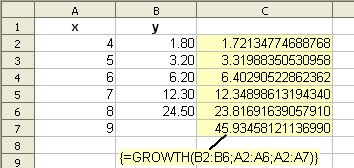Difference between revisions of "Documentation/How Tos/Calc: GROWTH function"
From Apache OpenOffice Wiki
< Documentation | How Tos
Javier Lopez (Talk | contribs) |
m |
||
| (3 intermediate revisions by 2 users not shown) | |||
| Line 1: | Line 1: | ||
| − | {{ | + | {{DISPLAYTITLE:GROWTH function}} |
| − | + | {{Documentation/CalcFunc ArraysTOC | |
| − | + | |ShowPrevNext=block | |
| − | + | |PrevPage=Documentation/How_Tos/Calc:_FREQUENCY_function | |
| − | + | |NextPage=Documentation/How_Tos/Calc:_LINEST_function | |
| − | | | + | }}__NOTOC__ |
| − | + | ||
| − | + | ||
| − | |PrevPage= Documentation/How_Tos/Calc:_FREQUENCY_function | + | |
| − | | | + | |
| − | + | ||
| − | + | ||
| − | + | ||
| − | + | ||
| − | + | ||
| − | + | ||
| − | + | ||
| − | + | ||
| − | + | ||
| − | + | ||
| − | + | ||
| − | + | ||
| − | + | ||
| − | + | ||
| − | + | ||
| − | + | ||
| − | + | ||
| − | + | ||
| − | + | ||
| − | + | ||
| − | }} | + | |
| − | + | ||
== GROWTH == | == GROWTH == | ||
| Line 42: | Line 16: | ||
: If <tt>'''allow_factor'''</tt> is <tt>'''FALSE'''</tt> the factor ''b'' in this equation is set to <tt>'''1'''</tt>; if <tt>'''allow_factor'''</tt> is non-zero, <tt>'''TRUE'''</tt> or omitted the factor ''b'' is calculated from the data. | : If <tt>'''allow_factor'''</tt> is <tt>'''FALSE'''</tt> the factor ''b'' in this equation is set to <tt>'''1'''</tt>; if <tt>'''allow_factor'''</tt> is non-zero, <tt>'''TRUE'''</tt> or omitted the factor ''b'' is calculated from the data. | ||
| − | : <tt>'''GROWTH'''</tt> returns an array of the y values of the exponential curve found, corresponding to the x values in <tt>'''new_xvalues'''</tt> (or if omitted <tt>'''xvalues'''</tt>). It must be entered as an array formula (for example by using | + | : <tt>'''GROWTH'''</tt> returns an array of the y values of the exponential curve found, corresponding to the x values in <tt>'''new_xvalues'''</tt> (or if omitted <tt>'''xvalues'''</tt>). It must be entered as an array formula (for example by using {{key|Cntrl|Shift|Enter}} rather than just {{key|Enter}}). |
: <tt>'''yvalues'''</tt> and <tt>'''xvalues'''</tt> must be the same size. <tt>'''new_xvalues'''</tt> may have a different size. | : <tt>'''yvalues'''</tt> and <tt>'''xvalues'''</tt> must be the same size. <tt>'''new_xvalues'''</tt> may have a different size. | ||
=== Example: === | === Example: === | ||
| − | [[Image:Calc_growth_example.png| | + | [[Image:Calc_growth_example.png|center]] |
| + | |||
<tt>'''=GROWTH(B2:B6; A2:A6; A2:A7)'''</tt> | <tt>'''=GROWTH(B2:B6; A2:A6; A2:A7)'''</tt> | ||
: when entered as an array formula in cell C2, where the x values in A2:A7 are 4, 5, 6, 7, 8, 9 and the y values in B2:B6 are 1.80, 3.20, 6.20, 12.30, 24.50, finds a best fit exponential curve for those points, and in C2:C7 returns y values on that curve for the x values in A2:A7. | : when entered as an array formula in cell C2, where the x values in A2:A7 are 4, 5, 6, 7, 8, 9 and the y values in B2:B6 are 1.80, 3.20, 6.20, 12.30, 24.50, finds a best fit exponential curve for those points, and in C2:C7 returns y values on that curve for the x values in A2:A7. | ||
| Line 54: | Line 29: | ||
<br style="clear:both;" /> | <br style="clear:both;" /> | ||
| − | {{ | + | {{SeeAlso|EN| |
* [[Documentation/How_Tos/Calc: TREND function|TREND]] | * [[Documentation/How_Tos/Calc: TREND function|TREND]] | ||
* [[Documentation/How_Tos/Calc: LOGEST function|LOGEST]] | * [[Documentation/How_Tos/Calc: LOGEST function|LOGEST]] | ||
Latest revision as of 11:11, 30 January 2024
GROWTH
Fits an exponential curve to a data set, and returns points on that curve.
Syntax:
GROWTH(yvalues; xvalues; new_xvalues; allow_factor)
- data is a range or array containing numerical data.
- yvalues and xvalues are single row or column ranges specifying points in a set of data.
- GROWTH fits an exponential curve of the form y=bmx through these data points, using the linear regression method.
- If allow_factor is FALSE the factor b in this equation is set to 1; if allow_factor is non-zero, TRUE or omitted the factor b is calculated from the data.
- GROWTH returns an array of the y values of the exponential curve found, corresponding to the x values in new_xvalues (or if omitted xvalues). It must be entered as an array formula (for example by using Cntrl + ⇧ Shift + ↵ Enter rather than just ↵ Enter ).
- yvalues and xvalues must be the same size. new_xvalues may have a different size.
Example:
=GROWTH(B2:B6; A2:A6; A2:A7)
- when entered as an array formula in cell C2, where the x values in A2:A7 are 4, 5, 6, 7, 8, 9 and the y values in B2:B6 are 1.80, 3.20, 6.20, 12.30, 24.50, finds a best fit exponential curve for those points, and in C2:C7 returns y values on that curve for the x values in A2:A7.
- This example shows how GROWTH may be used to predict future values (A7,C7).
See Also
